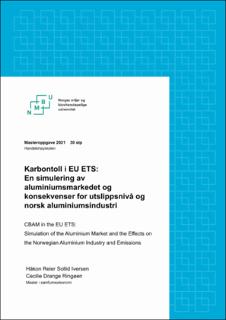| dc.contributor.advisor | Rosendahl, Knut Einar | |
| dc.contributor.author | Ringøen, Cecilie Drange | |
| dc.contributor.author | Iversen, Håkon Reier Sollid | |
| dc.date.accessioned | 2021-10-06T09:02:49Z | |
| dc.date.available | 2021-10-06T09:02:49Z | |
| dc.date.issued | 2021 | |
| dc.identifier.uri | https://hdl.handle.net/11250/2788036 | |
| dc.description.abstract | The EU is assessing new measures to reach their ambitious climate targets, as well as ensuring European competitiveness. This thesis examines a carbon border adjustment mechanism (CBAM) as a supplementary measure to counteract carbon leakage in the EU Emission Trading System. By using the aluminium market, we are assessing the effects an import tariff will have on global emissions and trade exposed industry in Norway compared to the current anti leakage measures. The results are based on an economic equilibrium model, consisting of four producers (Norway, The EU, China and Russia) and two markets; the European market and the world market. The results shows that the design of the import tariff and the combination with other anti leakage measures are of great significance for the producers, but not necessarily for the emission level. Changes in total emissions from the aluminium industry is between -0.1% and 0.7% depending on the composition of the anti leakage policies. The model also shows that the producer facing the highest tariff, withdraws from the European market in all scenarios. Further, the CO2 compensation scheme is critical for European producers, and it will weaken them greatly if the scheme emits from the policy package. We also find that the discontinuation of the compensation might lead to a high leakage rate. | en_US |
| dc.description.abstract | EU vurderer nye metoder for å nå fastsatte klimamål, samt sikre konkurransedyktighet for europeisk industri. Denne oppgaven undersøker karbontoll (CBAM) som en tilleggsmekanisme for å motvirke karbonlekkasje i EUs kvotesystem. Ved å bruke aluminiumsmarkedet, sammenlignes effekten av karbontoll med dagens anti-lekkasje virkemidler med hensyn på globalt utslippsnivå og norsk konkurranseutsatt industri. I oppgaven utarbeides en økonomisk likevektsmodell bestående av fire aluminiumsprodusenter (Norge, EU, Kina og Russland) og to markeder; det europeiske markedet og verdensmarkedet. Modellen viser at utformingen av karbontollen og kombinasjonen med andre anti-lekkasje virkemidler har stor betydning for produsentenes produksjonsnivå, men ikke nødvendigvis for samlede utslipp fra aluminiumsindustrien. Totale utslipp endrer seg mellom -0,1% til 0,7% avhengig av utformingen av anti-lekkasjepolitikken. Modellen viser også at produsenten som blir pålagt høyest karbontoll trekker seg ut av det europeiske markedet. Videre fremkommer det at karbonpriskompensasjonen er avgjørende for europeiske produsenter, og dersom denne bortfaller vil det svekke deres konkurranseevne. Vi finner også at et bortfall av karbonpriskompensasjon vil kunne føre til høy karbonlekkasje. | en_US |
| dc.description.sponsorship | ENABLE (Enabling the Green Transition in Norway) | en_US |
| dc.language.iso | nob | en_US |
| dc.publisher | Norwegian University of Life Sciences, Ås | en_US |
| dc.rights | Attribution-NonCommercial-NoDerivatives 4.0 Internasjonal | * |
| dc.rights.uri | http://creativecommons.org/licenses/by-nc-nd/4.0/deed.no | * |
| dc.subject | CBAM | en_US |
| dc.subject | EU ETS | en_US |
| dc.subject | Climate policy | en_US |
| dc.subject | Carbon leakage | en_US |
| dc.subject | Cost efficiency | en_US |
| dc.subject | Aluminium | en_US |
| dc.subject | CO2 emissions | en_US |
| dc.subject | Anti leakage measures | en_US |
| dc.subject | Import tariff | en_US |
| dc.title | Karbontoll i EU ETS : en simulering av aluminiumsmarkedet og konsekvenser for utslippsnivå og norsk aluminiumsindustri | en_US |
| dc.title.alternative | CBAM in the EU ETS : simulation of the aluminium market and the effects on the Norwegian aluminium industry and emissions | en_US |
| dc.type | Master thesis | en_US |
| dc.subject.nsi | VDP::Samfunnsvitenskap: 200 | en_US |
| dc.description.localcode | M-ECON | en_US |

